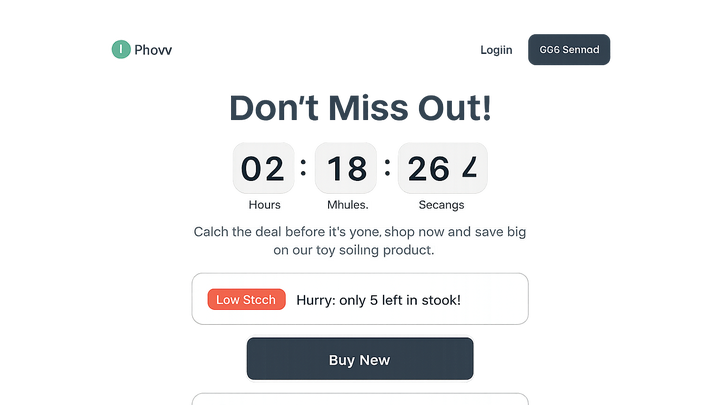Published on 2025-06-29T20:36:06Z
What is FOMO (Fear of Missing Out)? Examples for CRO, UX, and SEO
FOMO stands for Fear of Missing Out, a psychological trigger marketers use on websites to create urgency and drive user action. In the fields of conversion rate optimization (CRO), user experience (UX), and search engine optimization (SEO), FOMO techniques are applied to encourage prospects to act quickly by suggesting limited availability or social proof. By crafting messages that emphasize scarcity, exclusivity, and real-time activity, websites can boost leads and sales. Tools like Prevue.me identify FOMO elements on your site and provide actionable critiques to optimize your messaging, design, and strategy. When done effectively, FOMO can increase click-through rates, reduce bounce rates, and improve overall engagement. However, overuse or inauthentic implementation can erode trust and deter users. Balancing urgency with genuine value is key to leveraging FOMO ethically.
Fomo (fear of missing out)
Using FOMO tactics to create urgency on websites, boosting conversions, engagement, and leads.
Why FOMO Matters in CRO, UX, and SEO
FOMO leverages basic human psychology to drive action. When website visitors believe they might miss out on something valuable, they are more likely to engage immediately rather than postpone decisions. This sense of urgency can significantly improve conversion rates, reduce bounce rates, and increase session duration. Moreover, timely and relevant FOMO signals can also boost search engine signals by encouraging user engagement metrics. However, it’s crucial to balance urgency with authenticity to maintain trust and long-term brand credibility.
-
Boosting conversions
Urgency created by FOMO motivates users to complete actions such as signing up or purchasing, shortening the decision-making cycle.
-
Enhancing user engagement
Live activity feeds or countdown timers encourage users to stay longer and interact more with content or offers.
-
Improving seo signals
Higher engagement and lower bounce rates from FOMO tactics can send positive signals to search engines, potentially improving rankings.
Common FOMO Strategies for Website Optimization
There are several practical tactics to evoke FOMO on your site. These strategies should be employed thoughtfully to align with your brand and audience expectations. Testing and data-driven adjustments ensure that FOMO elements resonate without feeling forced.
-
Scarcity and limited availability
Displaying low stock indicators or limited slots for an offer drives users to act quickly before supplies run out.
- Low stock indicators:
Show the exact number of items left to create a visual cue of scarcity.
- Limited seats or spots:
Indicate limited access for webinars or events to push registrations.
- Low stock indicators:
-
Social proof and live activity
Demonstrating real-time user actions, such as recent purchases or sign-ups, suggests popularity and encourages similar behavior.
- Recent purchase notifications:
Pop-ups that display other users buying or signing up right now.
- Visitor counters:
Showing how many people are viewing a page concurrently.
- Recent purchase notifications:
-
Time-sensitive offers and countdown timers
Using countdown clocks for promotions or sales conveys a clear deadline, prompting faster decisions.
- Flash sales:
Short-term discounts that end quickly.
- Daily deal timers:
Offers that reset every 24 hours to maintain urgency.
- Flash sales:
Implementing and Testing FOMO with Prevue.me
prevue.me provides actionable critiques and insights to help you identify and optimize FOMO elements on your website. By leveraging its CRO, UX, SEO, and accessibility feedback, you can iteratively refine your urgency messaging for maximum impact.
-
Audit fomo triggers
Use prevue.me to scan your site for timers, scarcity messages, and social proof elements, highlighting gaps or overuse.
-
Design a/b tests for urgency messaging
Create and run experiments on headlines, button copy, and timing elements to see which variations drive higher engagement.
- Headline variations:
Test phrases like ‘Only 3 spots left’ versus ‘Hurry, offer ends soon’.
- Button copy tests:
Compare CTAs such as ‘Join Now’ against ‘Reserve Your Spot’.
- Headline variations:
-
Monitor and iterate based on data
Review prevue.me’s analytics to track conversion lifts, dwell time improvements, and user behavior changes after implementing FOMO tactics.
